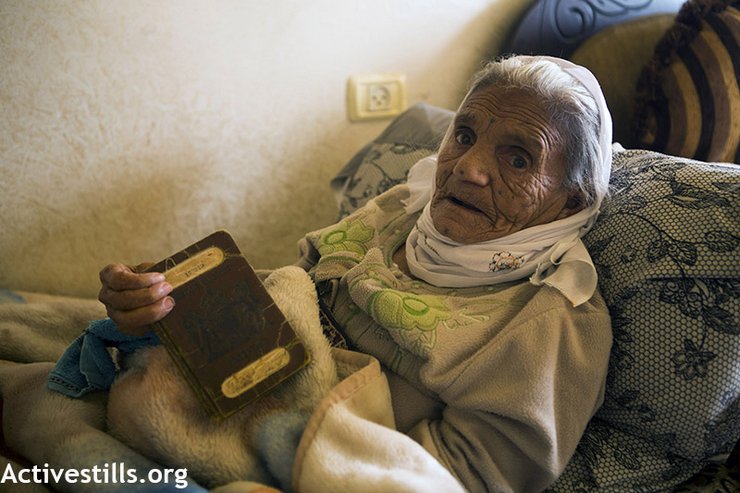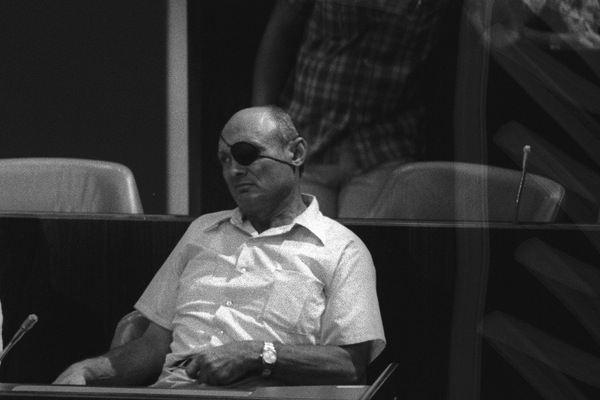A new government public relations clip shows Israeli Jews as the perpetual victims of history. But once upon a time Israeli leaders were able to consider the pain of others, too.
The Israel Ministry of Foreign Affairs managed to out-do itself on Thursday when it released its latest hasbara (state-sponsored PR) video of Jews as eternal victims of persecution in their homeland.
The clip tells the story of Rachel and Jacob, two contemporary Israeli Jews who live in a large, comfortable home, which is meant to be a metaphor for the Land of Israel. Slowly, the couple’s home is invaded and occupied by the Assyrians, the Babylonians, the Hellenists, the Romans, the Muslims, the Crusaders, Mamelukes, the Turks (just wait for the extremely Orientalist portrayal), and finally the British.
Each invasion pushes Rachel and Jacob into a smaller space in their home. The message is hard to miss: for 3,000 years the Jews have been subject to invasions and occupations in their homeland that have left them powerless and oppressed. Only the State of Israel has, finally, granted them a home they must fight to defend and protect at all costs.
Notably absent from the list of invaders are the Palestinians. But watch until the very end, when Rachel and Jacob’s Jewish home(land) is finally safe and secure: That’s when we see a suspicious-looking Palestinian couple knock on the front door and peer into the home. The symbolism is hard to miss: The angry Palestinians appeared in Israel, as if out of nowhere, to take over a land that never belonged to them.
The fact that the video portrays Palestinian refugees as potential usurpers is unsurprising, to say the least. At best, they are entirely absent from the Israeli public discourse — at worst they are widely viewed as a threat to the very existence of the Jewish state, not to mention a direct threat to Jewish presence in Israel-Palestine.
That’s because the very notion of Palestinian refugees has become nearly invisible to the average Israeli — a relatively new phenomenon that is the result of a stubborn attempt to craft a final-status solution to the Palestinian-Israeli conflict that makes cosmetic changes to the landscape without actually addressing the root cause of Palestinian indignation.
But it wasn’t always this way. In the early days of the state, Israel’s mainstream political parties argued tirelessly with and among one another about the fate of the nearly one million Palestinians who were uprooted and denied the right to return to their ancestral homeland, all while hundreds of thousands of Jews were granted to the right to come live in theirs.
Let’s not forget that before the First Intifada broke out in the occupied territories in 1987 (the first instance of widespread, organized Palestinian resistance inside historic Palestine since the Nakba), the question of Palestine, for the most part, still centered around the issue of refugees. And inside Israel, the fate of Palestinian refugees was part and parcel of the public discussion in the first decades following the establishment of the state. The questions we are afraid to ask today are the ones that then burned most intensely.

Israeli historian Benny Morris notes that the executive committee of Mapam, the predecessor to today’s Meretz party — considered as far left on the Zionist spectrum as one could get — opposed the expulsion of civilians and was in favor of the right of refugees to return to their homes after the war. Mapam also opposed the demolition of Palestinian homes that were left abandoned during the war, a policy that was swiftly enacted by Prime Minister David Ben Gurion to ensure that Palestinian refugees would have no homes to return to.
And while Mapam’s platform may seem radical in retrospect, the irony that its members took an active role in the expulsion of Palestinians was not lost on Ben Gurion. In The Birth of the Palestinian Refugee Problem, 1947–1949, Morris writes of a top-level Mapai (the ruling party headed by Ben Gurion and the predecessor to today’s Labor Party) meeting, on July 24, 1948, just two months after Israel declared independence and was invaded by the surrounding Arab armies, and eight months after the eruption of civil war between Zionist and Palestinian forces.
Citing the expulsions Mapam members carried out during the Battle of Mishmar HaEmek, the prime minister told his fellow party members: “They faced a cruel reality … [and] saw that there was [only] one way and that was to expel the Arab villagers and burn the villages. And they did this, And they were the first to do this.”
In the following months Mapam further diluted its position on the refugees, and following the Israeli government’s highly unpopular proposal to the UN, 28 July 1949, according to which 100,000 Palestinians might be allowed to return, the issue of return quietly dropped off the party’s agenda entirely.
Less than a decade later, Moshe Dayan, viewed by mainstream Israel as a larger-than-life military figure, eulogized a 21-year-old Israeli who was kidnapped near Kibbutz Nahal Oz by Palestinian gunmen, killed, mutilated and dragged into the Gaza Strip. In his analysis of the eulogy, Mitch Ginsburg calls it “an ethos that is succinct and brutal, pessimistic and defiant, unapologetic and, tragically, more important to the understanding of Israel today than are large swaths of the state’s own Declaration of Independence.” Dayan demonstrates that he was able to understand what drove the Palestinians just as well as he understood his own people. He had compassion for his enemy.

Read Dayan’s words, then read them again. You will be hard-pressed to find any Jewish-Israeli politician speaking this frankly about what drove Palestinians (very often refugees) to commit unconscionable acts against Israelis:
Yesterday with daybreak, Roi was murdered. The quiet of a spring morning blinded him, and he did not see the stalkers of his soul on the furrow. Let us not hurl blame at the murderers. Why should we complain of their hatred for us? Eight years have they sat in the refugee camps of Gaza, and seen, with their own eyes, how we have made a homeland of the soil and the villages where they and their forebears once dwelt.
Not from the Arabs of Gaza must we demand the blood of Roi, but from ourselves. How our eyes are closed to the reality of our fate, unwilling to see the destiny of our generation in its full cruelty. Have we forgotten that this small band of youths, settled in Nahal Oz, carries on its shoulders the heavy gates of Gaza, beyond which hundreds of thousands of eyes and arms huddle together and pray for the onset of our weakness so that they may tear us to pieces — has this been forgotten? For we know that if the hope of our destruction is to perish, we must be, morning and evening, armed and ready.
A generation of settlement are we, and without the steel helmet and the maw of the cannon we shall not plant a tree, nor build a house. Our children shall not have lives to live if we do not dig shelters; and without the barbed wire fence and the machine gun, we shall not pave a path nor drill for water. The millions of Jews, annihilated without a land, peer out at us from the ashes of Israeli history and command us to settle and rebuild a land for our people. But beyond the furrow that marks the border, lies a surging sea of hatred and vengeance, yearning for the day that the tranquility blunts our alertness, for the day that we heed the ambassadors of conspiring hypocrisy, who call for us to lay down our arms.
As opposed to the Nakba-denial that has become all too common today in Israel (and the American Jewish community) Moshe Dayan speaks candidly, and even goes so far as to humanize — perhaps more candidly than just about any other mainstream Israeli leader — Palestinian suffering. Instead of offering revenge, he pleads with the Israeli public to understand that the removal of a native population and its replacement with a settler population necessarily entails a great deal of violence. For decades those aforementioned barbed wire fences and machine guns have been widely viewed by Israelis — and the Western world — as a means for Israel to protect itself at all costs. But those barbed wires fenced in thousands upon thousands of families; those machine guns took the lives of countless others. What Israelis view as self-defense has, from day one, been an assault on a people turned into refugees.
Dayan, one of Israel’s most contentious political figures, was a ruthless commander. Perhaps more than anybody, he is responsible for Israel’s immutable ethos of “living by the sword” — the same one adopted by Prime Minister Netanyahu a year ago. But just before the conversation on the Nakba becomes completely walled off, whether by public pressure or institutional power, it is worth remembering that once upon a time, Israelis at the very highest level of government could actually speak overtly about this issue.
Twenty years before they were again invaded and then placed under military rule in 1967, the Palestinians were expelled from their ancestral homeland. Dayan’s “eight years” have turned into 68. We Israelis must understand that that anger has not and will not subside, and no amount of glossy, government-sponsored propaganda will be able to silence it.


